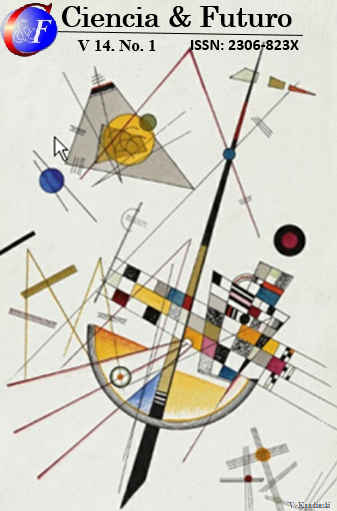Metallurgical continuity of an ASTM A 36 steel with preparation of edges at different angles
Keywords:
alloys, welding defects, metallurgical discontinuity, welded jointsAbstract
The metallurgical continuity of an ASTM A 36 steel with edge preparation at different angles was determined. Non-destructive tests were used, such as liquid penetrant, ultrasound and radiography, as well as deformations when being welded with electrode E 7018 and 30° and 35° bevels. The imperfections and discontinuities found in the weld were obtained, referring to the design, metallurgical behavior and welding process, where the latter was the one that had the greatest impact on the joint. Finally, with a longitudinal wavelength of 4376.78 m/s and a superficial one of 2884.49 m/s, it was found that in the 30° bevel there are two longitudinal cracks at a length of 9.6 mm and 1.3 mm deep, in addition the 35° bevel showed a lack of penetration of 1.25 mmDownloads
References
Easterling, K. (1983). Introduction to the physical metallurgy of welding. Butterworths.
Fernández-Columbié, T., Suárez, L. & Rodríguez, I. (2021). Influencia de la temperatura en la soldadura de unión disímil mediante proceso de gas y tungsteno. Revista de Iniciación Científica, 7(1), 24-29. https://revistas.utp.ac.pa/index.php/ric/article/view/3050.
García-Rodríguez, Y. & Burgos, J. (2007). Procedure for the obtaining by means of MEF of the thermal fields, deformations and residual tensions in welded unions. Revista Técnica de la Facultad de Ingeniería Universidad de Zulia, 30(1), 13-22. http://ve.scielo.php?script=sci_arttext&pid=S0254-07702007000100003&Ing=es&ting=es.
González-Cabrera, O., Gómez-Pérez, C., Perdomo-González, L. & Vázquez-Badillo, E. (2017). Comportamiento de la resistencia al desgaste entre depósitos obtenidos con electrodos simple y doblemente recubiertos. Soldagem & Inspeção, 22(1), 87-98. http://old.scielo.php?script=sci_arttext&pid=A0104-92242017000100087.
Halmshaw, R. (1991). Nondestructive Testing, Edward Arnold.
Ilyashchenko, D., Chinakhov, D. & Gotovshchik, Y. (2015). Calculation of the heat content of the electrode metal droplet when applying power supplies for manual arc welding with different volt-ampere characteristic. Applied Mechanics & Materials, 756(200), 101-104. https://www.scientific.net/AMM.756.101.
Maddox, S. (1994). Applying Fitness-for Purpose Concepts to the Fatigue Assessment of Welded Joints. The International Conference on Fatigue, 1(1), 72-81.
Rodríguez, O. (2014). Defectos y controles de uniones soldadas en soldadura manual. Editorial Universitaria.
Varia, V. & Ganatra, Y. (2013). Ultra sonic testing of welded joints prepared at different voltage and current. International Journal of Research in Engineering and Technology (IJRET), 2(11), 738-742. http://www.ijret.org.
Published
How to Cite
Issue
Section

This work is licensed under a Creative Commons Attribution-NonCommercial 4.0 International License.
Esta obra está bajo una Licencia Creative Commons Reconocimiento-NoComercial 4.0 Internacional
La Revista Ciencia & Futuro es una revista de acceso abierto, todo el contenido está disponible gratuitamente sin cargo para el usuario o su institución. Los usuarios pueden leer, descargar, copiar, distribuir, imprimir, buscar o vincular los textos completos de los artículos, o utilizarlos para cualquier otro fin lícito, sin pedir permiso previo al editor o al autor. Todo lo anterior, de acuerdo con la definición de BOAI de acceso abierto.
Los autores que publican en esta revista están de acuerdo con los siguientes términos: Licencia Creative Commons Atribución-NoComercial permite que el beneficiario de la licencia tenga el derecho de copiar, distribuir, exhibir y representar la obra y hacer obras derivadas para fines no comerciales siempre y cuando reconozca y cite la obra de la forma especificada por el autor o el licenciante. Los autores pueden establecer por separado acuerdos adicionales para la distribución no exclusiva de la versión de la obra publicada en la revista (por ejemplo, situarlo en un repositorio institucional o publicarlo en un libro), con un reconocimiento de su publicación inicial en esta revista. Se permite y se anima a los autores a difundir sus trabajos electrónicamente (por ejemplo, en repositorios institucionales o en su propio sitio web) antes y durante el proceso de envío, ya que puede dar lugar a intercambios productivos, así como a una citación más temprana y mayor de los trabajos publicados (Véase The Effect of Open Access) (en inglés). Lo anterior debe realizarse siempre sobre el artículo ya publicado por Ciencia & Futuro.
Los autores mantienen el control sobre la integridad de sus trabajos y el derecho a ser adecuadamente reconocidos y citados.
A los editores se les otorgan derechos no exclusivos para publicar y distribuir.



